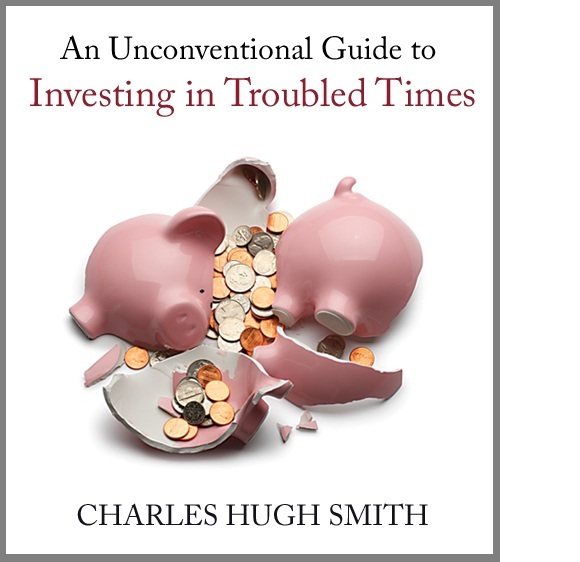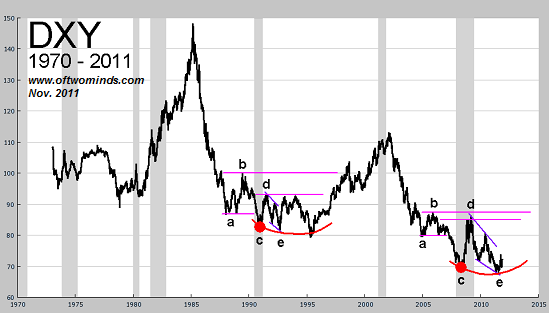Unleashing the Future: Advancing Prosperity Through Debt Forgiveness (Part 3)
This week we present a timely and important series on debt renunciation and forgiveness by longtime contributor Zeus Yiamouyiannis. Today: Part 3: Administering debt forgiveness.
As I write, "risk trade" assets are skyrocketing around the globe as central banks unleash a tsunami of liquidity. Giving bankrupt entities the ability to borrow more money does not make them solvent, and so if we look past the manic rally in speculative assets, we see that debt will still have to be renunciated, written down, forgiven, wiped off the books--whatever terminology you prefer.
PART 3: Administering debt forgiveness to restart the global value scale, promote productivity, and ensure fairness
Ultimately, debt forgiveness starts from the need for global social self-preservation. Succeeding generations will not or cannot continue the easy credit charade, so zeroing out debt, prosecuting fraud, and pursuing bankruptcies to those who have overextended themselves, including “too big to fail banks,” is necessary to get the monkey off the back of the global economy and future generations. This will have to be done in a way to prevent future abuse, open up opportunity, and reinforce a healthy productivity.
Again, when debt is both unsustainable and largely fraud, debt forgiveness is the last and only remedy. No other responses have come close to adequately dealing with the systemic enormity of the problem. Current conventional attempts at reform are some version of “extend and pretend” (“solving” debt with more debt) or “hide and seek” (valuating assets mark-to-fantasy and stashing liabilities off the books). Those are not solutions; they are pipe dreams.
Productivity, prosperity, and well-orchestrated debt forgiveness align up on one side, and austerity and debt expansion align on the other in this challenge. We’ve already seen the trajectory of the latter choice. It accelerates concentrations of wealth and control, damaging democratic governance, creating personal misery (as seen with upticks in those in poverty and without medical care), stirring violence and unrest, and destabilizing societies. When the wrong things are being valued and rewarded, people have the right and duty to resist, and they are resisting.
Currently present and future generations are literally and metaphorically being imprisoned through the attempted enforcement of non-enforceable and fraudulent debt. Paying off a hopeless mortgage is a form of house arrest. In this climate, debt forgiveness is based on a very clear and rational decision: Restorative justice for people currently paying off fraudulent or untenable liabilities (largely run up and foisted on them by others) is far more important than the prospect of having selected opportunists “taking advantage of the system” to discharge valid debts.
The system is far more broken than the people in it, and if reformed with canny foresight and wisdom, can actually reward those willing to produce and insist upon other forms of pro-social volunteer effort as “payment” for those who do not have money. This is called picking up the pieces and working in good faith.
Arguments for and against debt forgiveness: Facts and falsehoods
When confronted with the option of debt forgiveness, many citizens argue that loans are some kind of sacred cow and that debt forgiveness would reward irresponsibility. Their simplistic truisms usually ignore context and inevitably focus on the moral or contractual obligations of low-level operators and borrowers (“You signed it; you have to pay it off no matter what.”). The context and truth is this: Massive debts have been run up in our global financial system at all levels, the most egregious by those with the most power, and by those enriching themselves by extracting ever greater pounds of flesh from tax payers and borrowers.
So let’s get dispense some truth to challenge the myths:
The biggest thieves, the most immoral, criminal, and irresponsible debt players by far have been those who have been enriched the most from our current debt system. Look no further than “too big to fail banks” who profited enormously from fraud in the lead-up to financial meltdown, blew up the system in 2008, got bailed out with tax payer money, and then promptly rewarded themselves with 144 billion dollars in bonuses a year later. Mom and pop underwater mortgage holders are not the problem.
Even if a borrower takes out a loan that he or she can comfortably afford and saves up a six-month emergency fund, that borrower can get behind through illness or job loss or other unanticipated event. For larger borrowing economies these events could be peak oil or global warming or any number of strains that are not accounted for and that significantly interrupt or alter growth trajectories.
Add to this modern finance where money-to-debt ratio is widening through fractional reserve banking and complex leveraging, and we can note that only a small fraction of total debt could physically be paid off. That means morally- and practically-objectionable debt slavery for the vast majority of loan holders, as their productive efforts go into paying off interest to faceless institutions rather than investing in families and communities.
As mentioned earlier: 1) Debt that cannot be paid is already default. By this measure many countries (Greece, Italy, Spain, U.S.) are already in default. Pretending otherwise (through austerity measures, etc.) will simply stress the body politic to the breaking point and beyond. 2) Current debt is unenforceable because people do not have the money, jobs, or assets to pay them due to unprecedented global economic contraction. 3) There is so much fraud and counterfeit value in the current system (700 – 1,000 trillion in derivatives alone), that current real assets cannot cover liabilities. 4) Government welfare promises/entitlements in most countries, due to a post-WWII population bubble, far outstrip the capacity of future generations to deliver on them.
By laboring under a “debt as natural/moral law” delusion, world economies are trying to essentially drain the sea of international debt by bailing the sea into the boats of national economies and on to the backs of productive citizens. This approach is not working; that sea of international debt is growing beyond control due to its colossal size coupled with compound interest. We know that national austerity cannot come close to solving this predicament, so why are we pretending? The truth is we, the regular citizens, are not pretending. We have to live the reality of increasing debt and diminished material opportunity. It is powerful leaders and the financially rich and influential who have covered their eyes to distance themselves from the consequences of their own collapsed designs.
This peek-a-boo approach of current world leaders will only delay the day of reckoning and thus to make the economic and political consequences worse. Their approach is a recipe for violent revolt, economic freeze-up, panic, shortages of vital goods, and ironically their own endangerment. Ordered deleveraging will not be sufficient at this point, since levered value has already illegally been converted into counterfeit “actual” value by an unregulated shadow banking system: This counterfeit “notional” value not only swamps people’s ability to pay, but might even eclipse the value of all real assets in the world (unless, of course, you mark those to fantasy as well).
Even a egomaniacal two-year-old will grudgingly admit that there are no more cookies in the jar once he as eaten them all. This is far better than adult bankers who decided to make up imaginary “cookies” to dispense from that same jar (based on leverage or fractional reserve), and then expect people to hand them back real cookies (money, labor, and assets) in exchange for these concocted cookies. When we support debt forgiveness we are left with a zeroed scale, and therefore any “cookie” added will be from our own creativity, effort, and good sense. That is a far better place to be than less-than-zero where our efforts go to resupply imaginary value.
The system is not unsustainable; it is already broken, and needs to be put on a path of real, concrete productivity and growth (labor, learning, creative application, quality of life, etc.), not malignant expansion of credit and debt. My argument is that debt forgiveness is an essential mover in this necessary transformation. Debt in its current ideological form, must be decisively repudiated in practice and replaced with a working system based on healthy, productive principles.
This process of repudiation includes extinguishing delusional economic assumptions and practices—the parasitic “skim-scam” of “internalizing gains and externalizing liabilities” in an inherently interconnected system, and the addictive habit of leeching off the future. Transformation involves “paying forward” our talents and investment in the growth of a stronger, safer, and more solvent future. This will be discussed in the next part.
(by Zeus Yiamouyiannis, Ph.D., copyright 2011)
About this series: Given accelerating conditions and trends in Europe, the U.S. and Asia, debt will be renounced, forgiven or written down, and how that process unfolds is now of paramount importance. Will private entities who dined so gloriously on their profits now eat their losses? Can the public who has seen its fortunes commandeered mount an effective response? Will there be convincing practical alternatives to a rigged world economy based in debt expansion and servitude? The answer is "yes" to all three, contends this five-part series by longtime contributor Zeus Yiamouyiannis. The series offers practical analyses and blueprints for liberating the world from debt and thus freeing its people to pursue greater, more productive purposes. CHS
Unleashing the Future: Advancing Prosperity Through Debt Forgiveness (Part 1)(November 28, 2011)
Unleashing the Future: Advancing Prosperity Through Debt Forgiveness (Part 2)(November 29, 2011)
If this recession strikes you as different from previous downturns, you might be interested in my new book An Unconventional Guide to Investing in Troubled Times (print edition) or Kindle ebook format. You can read the ebook on any computer, smart phone, iPad, etc.Click here for links to Kindle apps and Chapter One. The solution in one word: Localism.
My Big Island Girl(song) Thrill the players to bits by buying the tune from CD Baby or amazon.com (99-cent MP3 download)
Four new electric instrumentals by Coconut Charlie, CHS's longtime friend and musical mentor--give 'em a listen:
Crash Course Secret Asian Man Third Stone Tonic Float
Readers forum: DailyJava.net.
Order Survival+: Structuring Prosperity for Yourself and the Nation (free bits) (Mobi ebook) (Kindle) or Survival+ The Primer (Kindle) or Weblogs & New Media: Marketing in Crisis (free bits) (Kindle) or from your local bookseller.
Of Two Minds Kindle edition: Of Two Minds blog-Kindle
| Thank you, Ian C. ($10/mo), for your superbly generous subscription to this site-- I am greatly honored by your support and readership. |






























